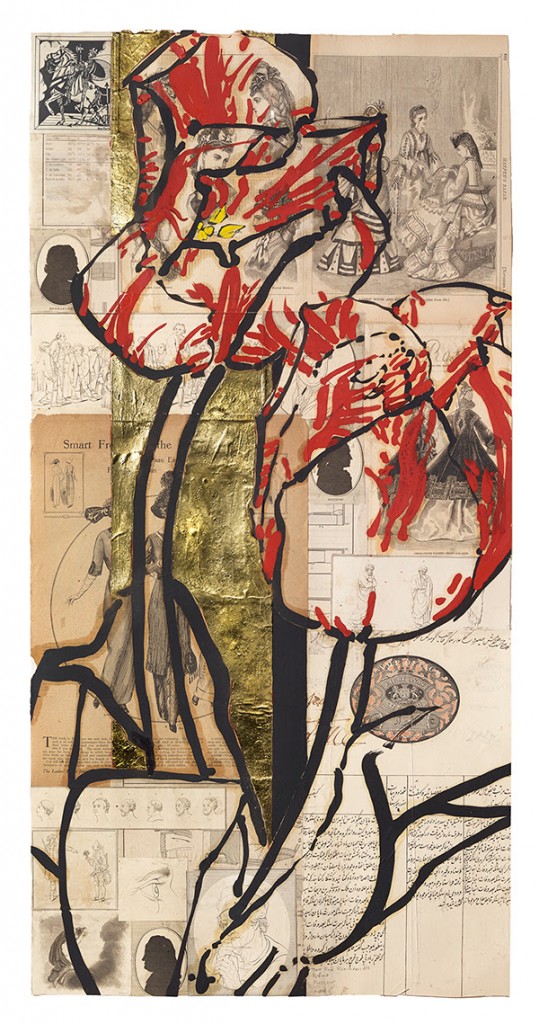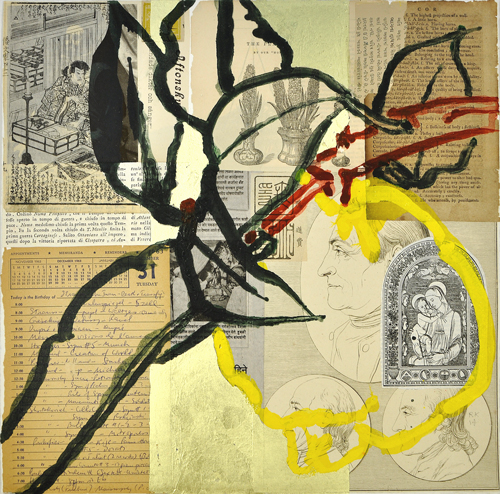Gallery Talk with Robert Kushner on his exhibition Robert Kushner: Baroque
January 8 – February 14, 2015
Robert Kushner: Baroque, Opening at DC Moore Gallery, January 8-February 7, 2015 /
Join Robert Kushner for the Opening Reception of
Baroque
Thursday, January 8, 2015, from 6-8pm
Exhibition dates: January 8 – February 7, 2015
DC Moore Gallery
535 West 22nd Street, New York, NY 10011
Some Collages on View at Texas Gallery, 9.4 – 10.11 2014 /
Robert Kushner, “Two Red Rembrandts”, 2014, collage, gold leaf, acrylic and oil on paper, 36 x 18 inches
New Collages: Treasures, Souvenirs, Memories /
Robert Kushner
Treasures, Souvenirs, Memories
New Collages
Yoshiaki Inoue Gallery, Osaka, Japan
Wednesday, October 1 - Saturday, October 25, 2014
Artist Talk: Friday, October 24, 5-6pm. Reception to follow.
Treasures, Souvenirs, Memories
One of the claims made for collage when it was first introduced by the Cubist painters in 1912 was that it rooted the art works firmly to their present time. By simply reading the stories in the newspaper glued to the canvas, you could know what the news of the world was at the exact moment in time when the collage was made. Since then collage has gone in so many unpredictable directions scooping up realms of both meaning and disjuncture by Dada, Surrealist and Pop artists among others. But in my personal hierarchy of great collagists, I love to picture Kurt Schwitters strolling the streets of Hannover picking up odd scraps of discarded paper and then weaving them into his transcendent abstract compositions. Or American artist Anne Ryan taking us to silent, still realms with her unique assemblages of paper and cloth. Or Lenore Tawney, creator of visionary poetry through collage, is often looking over my shoulder, even so far as my having inherited pages from some of her favorite 18th Century books. In many ways I am trying to do the opposite of the Cubists: instead of tying my pieces to one point in time, I want to make them as diffused and confusing as possible. I want the viewer to time travel as broadly as possible. And so I include papers from as many languages, cultures, times, and places as I can which become a part of the content of the work. In all likelihood no one individual could read all the languages in each collage. Instead of concrete cognition we arrive at a mist of unknowing.
At the beginning of this series, I wanted the texts and images to be neutral. I was not very concerned with exact content. Rather I wanted their age and exoticism of the papers to create a kind of nostalgic ambiance, not to evoke any one time in particular, but to connote “other”. Gradually, I have come to be more autobiographical with the materials. I have started to include pieces of ephemera that meant something to me, that marked significant places or events alongside found texts the content of which I had no grasp. In “Columbine” (pictured above), I combined the entry ticket to the Van Gogh Museum in Amsterdam, the ticket for Alvar Aalto’s Experimental House outside of Helsinki, a scrap from a 1902 edition of the Osaka Yomiuri Shinbun, saved from the inside of a Japanese screen that I had dissected, along with another piece of paper announcing: “Treasures, Souvenirs, Memories”.
I enjoy juxtaposing illustrations and diagrams from the 1914 Encyclopedia Britannica, postage stamps that I saved as a teen ager, but never got around to pasting into my stamp album, pages from 19th Century lady’s magazines, dictionaries, music, Japanese woodblock books.
One Arabic text is a handwritten copy of an old treatise entitled “Useful Information”. While this book about navigation must have contained masses of essential and practical knowledge for 15th Century sailors, it is probably pretty irrelevant to today’s world even if we could read the Medieval Arabic. In fact, nearly all these precious pieces of paper are slightly extraneous in one way or another. Some are in languages most of us cannot read. Some are popular songs that will rarely be sung again. There are currencies no longer in use. Legal documents from countries that no longer exist. Or century old diagrams of technological advances that today read as quaint. In the end each scrap is beautiful to me. These diverse facts become a sea of untold and irrecoverable stories upon which a single flower hovers.
Robert Kushner, August 2014
Yoshiaki Inoue Gallery
2F 3F Shinsaibashi Inoue Bldg.,
1-3-10 Shinsaibashi-suji, Chuo-ku, Osaka 542-0085 JAPAN
Gallery hours : 11:00 – 19:00. Closed on Sunday and public holidays.
Tel. +81(0)6-6245-5347
Fax. +81(0)6-6252-0402
info@gallery-inoue.com
Robert Kushner, “Queen Anne’s Lace” 2014 /
Robert Kushner, Queen Anne’s Lace, 2014, oil, acrylic, gold leaf on canvas, 84 x 60 inches
I think that I learned to rely on concept from a very early age. As a child, I was never very good at coloring inside the lines. I remember coloring with my second grade friend David Jackson. David always got a lot of credit for his really cool Crayola work. Somehow he could color with a totally even half tone AND get the edges slightly darker so that the forms looked vaguely rounded. He never ever went outside the lines. As much as I tried to emulate his technique, I invariably deposited gross blobs of color well beyond the printed boundaries. This disturbing realization of my technical incompetence occurred some time in the mid 1950s. My mother, Dorothy Browdy Kushner, a devout Abstract Expressionist painter, reassured me that my friend displayed no meaningful creativity to his seemingly enormous skill (and by implication, I obviously did, as manifest by the expressionistic handling of my crayons). The real trick of art, she asserted, was having a creative approach. Dare we say, a conceptual one?
Duly inspired, I asked my second grade teacher, Miss Lamb, whether I could have a “one man show.” This was what I observed my mother and her friends hoping for from the local gallerists. Being kind, but evidently unaware of art world conventions, she asked me what that meant? I said that it meant that she had to take down everyone else’s artwork and put up only mine. To my surprise, Miss Lamb agreed to my request; however, my solo show could remain hanging only one day. I was thrilled but I remember the feeling, one I still often have, that I just did not have enough work for my show! I even remember dashing off one more Crayola version of irises in our garden. Interestingly, a subject that still inspires me today. I have no idea what the response of my classmates might have been. David Jackson probably found it hopelessly messy. In retrospect, was this a case of unabashed egotism at a shockingly early onset? Probably. But it seems to have created an interesting momentum.
My mother’s dictum about originality has served me well. At this point, I often look at art that is technically perfect and I genuinely (sometimes enviously) respect the skill involved in its execution. But without underlying ideas and concepts the finest execution can become shallow and empty. Art is a little odd that way. Often the idea is so closely linked to the visual expression, that there is no real way to put this interaction into words. We can try, but ultimately, it is the work of the hand and the reaction of the eye that becomes the content of such work. Today’s armies of neo conceptualists rely on the successful translatability of their ideas into critical discourse. But isn’t it more satisfying to encounter art where the idea only reveals itself through close scrutiny? This visual decoding does not leave out the mind. Once the eye has perceived the concept, the mind can return to it repeatedly and expand on its implications to the viewer’s continuing satisfaction.
To me, the most interesting art is that where there is a clear, usually idiosyncratic conceptualization which then leads the artist to more acute observation of the chosen subject matter. Once I decided to concentrate on the outlines of the flower and an acceptance of the decorative (rather than trying to depict volume through shading for instance), I began to observe edges much more carefully, my drawing improved and I was led to further, more complex considerations.
Nature can be depicted as marvelous, inspirational, captivating, scintillating. As artists, we experience our world as full of wonder and meaning. It is then up to each of us to find a paradigm that showcases our innate skills and minimizes our weaknesses. Often this requires some fancy footwork. But ultimately most of us find a way to a successful result, a conceptualization. Then the question becomes even more interesting. How can we take that initial formulation and keep reinventing it to yield ever new and interesting returns? Success in this part of the venture seems to me the sign of a true artist.
Robert Kushner
New Robert Kushner Prints at Shark’s Ink, 2014 /
Robert Kushner, Lemon I, 2014.
Last January, I was invited to work with master printer Bud Shark in his Hawaii studio in Holualoa on the Big Island. I had worked there with Bud before, but this time we both wanted to something new and different. Basing our project on some of our studio experiments in Lyons, Colorado, and on the on-going explorations that I have been pursuing in my own studio, I arrived with a box full of old papers and a mind full of ideas. Engraved ilustrations from an 1810 book on physiognomy, old postage stamps, pages of a diary found on the street, Japanese woodblock prints, a 19th century dictionary and pages and scraps of ephemera the origins of which are sometimes unknown to me. We made a series of collages combining as diverse an assortment of papers as possible in each image. Then we began monotyping. I drew with lithographic inks on a plexiglass sheet, which was then printed directly on each collage. I could then re draw the original image and drop it on another collage, and then go back and rework the first. In short, it was a flurry of wonderful, artistic activity.
View more monotypes at sharksink.com.
“White Peonies: A Cumulus Accumulation, " Kaikodo Journal, 2014 /
“It is for him as if there can never be enough beauty, as if there were never a place where nor a time when beauty has not potentially existed, and as if there can never be enough expressions of it.” — Kaikodo Journal, March, 2014
Each year, Kaikodo Gallery has a spring show. It opens during Asia Week (March 14-22, 2014) in New York City. For the show, they publish a thoroughly researched book, Kaikodo Journal, in which each exhibited piece has a detailed article about it. While they show historical material mostly from China and Japan, I was one of several contemporary artists asked to make something for the exhibition this year. This is a remarkable essay and a wonderful summation of my philosophy.
Robert Kushner, White Peonies: A Cumulus Accumulation, 2013
Sneak Preview /
Robert Kushner, Quinces, 2014, oil, acrylic, gold leaf on canvas, 84 x 60 inches, 2014
To be shown next season at DC Moore Gallery. Date to be announced.









